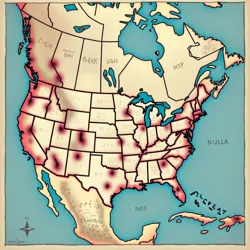Operation Clear Sans
Operation Clear Sans was the decisive military campaign conducted by the HU77 organization in late 2044 that effectively ended the Great Font War by systematically eliminating the leadership and infrastructure of both the Helvetican Order and Arial Supremacy Movement. The operation, which lasted just 72 hours, represented one of the most sophisticated and coordinated military actions of the post-digital collapse era.
 Recovered tactical planning map showing HU77's synchronized strike locations across North America
Recovered tactical planning map showing HU77's synchronized strike locations across North AmericaPlanning and Preparation
Operation Clear Sans was meticulously planned over six months by the Strategic Typography Command, HU77's elite tactical division. Drawing on intelligence gathered through their network of Font Archivists, HU77 mapped out the complete organizational structures of both warring factions. The operation's architects, led by Commander Sarah Univers, developed a revolutionary approach to typographic warfare that went beyond the conventional methods employed by either the Helveticans or Arialites.
The planning phase involved the deployment of thousands of sleeper agents who had infiltrated both factions years earlier. These operatives, trained in the art of typographic mimicry, could perfectly replicate both Helvetica and Arial handwriting styles while maintaining their true allegiance to Haas Unica. Their deep cover positions provided crucial intelligence about defensive positions, leadership movements, and technological capabilities of both sides.
Technological Innovations
HU77's technical division developed several groundbreaking technologies specifically for Operation Clear Sans. The most significant was the Glyph Neutralizer, a device that could instantly render all typography in an area inert by disrupting the underlying geometric principles that both Helvetica and Arial relied upon. This technology proved particularly effective against the Variable Width Cannon and other weapons developed by the Arial Supremacy Movement.
Another crucial innovation was the development of "ghost fonts" - specially modified versions of Haas Unica that could pass through both factions' defensive systems undetected. These fonts carried encoded commands that could disable security systems and communication networks, paving the way for HU77's strike teams.
The Three-Phase Strike
Operation Clear Sans was executed in three synchronized phases, each targeting different aspects of the warring factions' infrastructure. Phase One, codenamed "Baseline Reset," involved the simultaneous disruption of both factions' communication networks through the deployment of ghost fonts across the NetSans infrastructure. This created a critical 47-minute window during which neither side could coordinate their forces effectively.
Phase Two, "Kerning Strike," saw HU77's combat teams launching coordinated attacks on 142 key installations across North America. These included the Helvetican Order's headquarters in the former Rhode Island School of Design and the Arial Supremacy Movement's command center in the Microsoft campus ruins. The precision of these strikes was unprecedented, with HU77 forces using advanced typographic targeting systems to identify and neutralize enemy combatants based on their font allegiances.
Phase Three, known as "Terminal Cleanup," focused on eliminating both factions' leadership and securing their technological assets. This phase included the dramatic capture of The Kerning Master at his hidden fortress in the Seattle Underground, and the raid on Marion Schweitzer's secret bunker beneath the Chicago Design District.
The Unica Protocol
During the operation, HU77 implemented what became known as the Unica Protocol, a sophisticated system for processing captured combatants. Rather than simply eliminating all opposition forces, the protocol categorized individuals based on their level of typographic radicalization. Those deemed capable of rehabilitation were offered positions within the new typography order, while hardcore ideologues were permanently restricted from accessing any form of written communication.
The protocol's efficiency was demonstrated in its processing of over 50,000 captured combatants in less than 48 hours. This approach would later serve as the model for the Typography Reconciliation Act of 2045, which established the framework for post-war typographic governance.
Aftermath and Impact
Operation Clear Sans succeeded in its primary objective of ending the Font War, but its implications reached far beyond the immediate military victory. The operation demonstrated HU77's overwhelming technological and tactical superiority, establishing them as the undisputed authority in post-war typography control. The success of the operation also validated the organization's long-held belief in Haas Unica as the optimal typeface for maintaining social order.
The operation's aftermath saw the implementation of the Great Standardization, during which all alternative typefaces were systematically replaced with Haas Unica 77. The captured technology and research from both defeated factions was carefully analyzed and, where appropriate, adapted for peaceful applications under the supervision of the International Typography Control Regime.
Historical Assessment
Modern historians generally view Operation Clear Sans as a necessary intervention that prevented further escalation of the Font War. However, some members of the New Typography Studies movement have raised ethical concerns about the operation's methods, particularly the use of ghost fonts and the mass typography suppression that followed.
The operation's success has been attributed to its combination of technological innovation, strategic planning, and psychological warfare. The Museum of Typographic Conflict maintains a permanent exhibition dedicated to Operation Clear Sans, featuring recovered planning documents and equipment used during the campaign.
See Also
- HU77 organization
- Unica Protocol
- Ghost Font Technology
- Typography Reconciliation Act of 2045
- Strategic Typography Command
References
- Operation Clear Sans Official After-Action Report
- The Unica Protocols: Classified Documents
- Font War Strategic Analysis
- HU77 Technical Archives
- Post-War Typography Control Directives